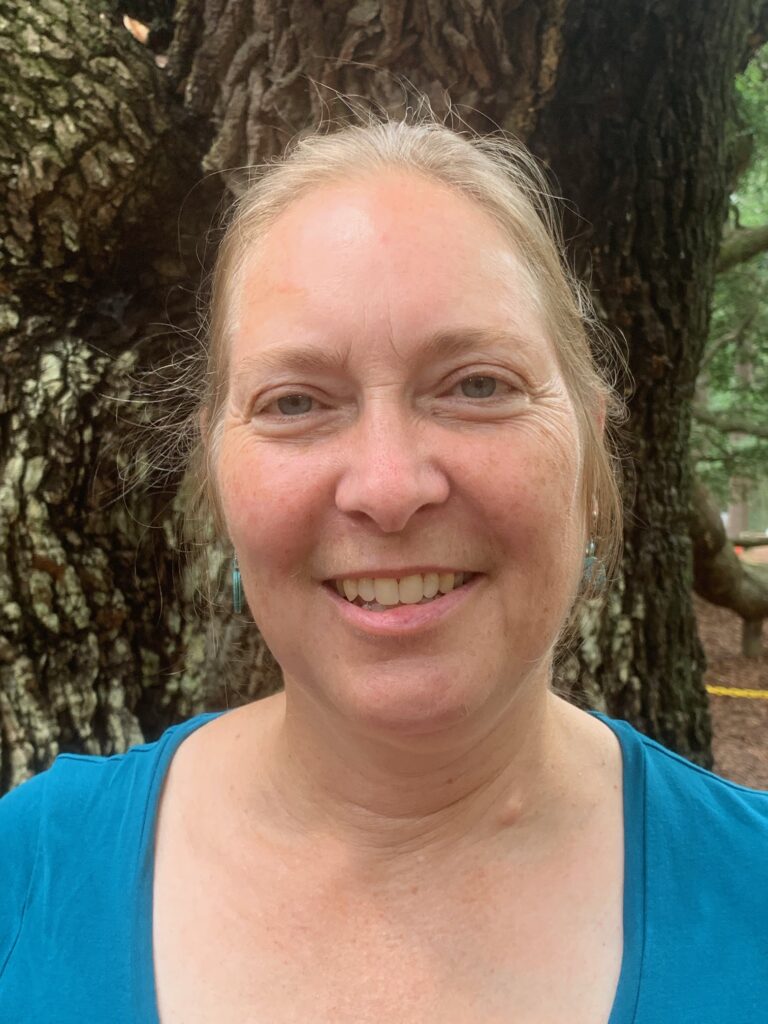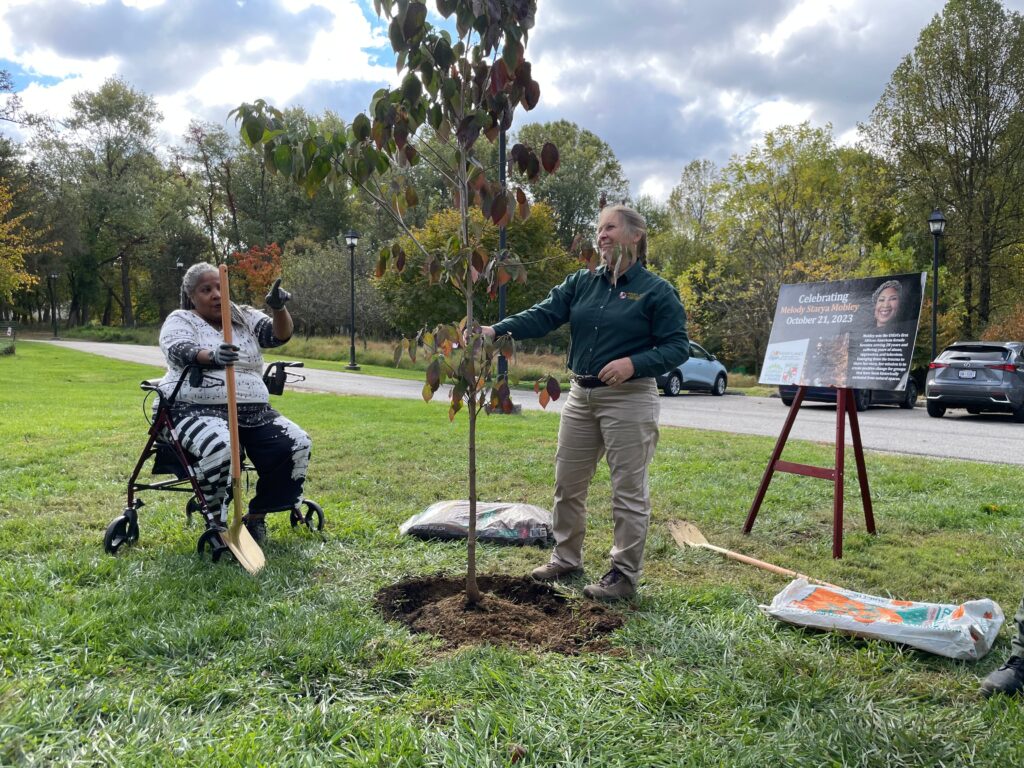THE LEAFLET

Learning About our Regional Forests
Historically at Casey Trees, we’re an organization that focuses on restoring, enhancing, and protecting the tree canopy of our nation’s capital. But understanding that our tree canopy, and the tree canopy of neighboring jurisdictions, are dependent upon one another’s health and sustainability, we often partner with organizations across the DMV region. We all see the benefits and adverse effects of changes to our neighbors’ tree canopy. So, we make a strong effort to reach out to regional partners, learn from one another, celebrate our achievements, and see what is possible when we work together.
 In that spirit of partnership – we recently had the chance to speak with Anne Hairston-Strang, newly appointed State Forester for Maryland (November 2023), and the first woman to hold the position. We asked her about her time and experience at the Maryland Forest Service (Department of Natural Resources) and about her current projects.
In that spirit of partnership – we recently had the chance to speak with Anne Hairston-Strang, newly appointed State Forester for Maryland (November 2023), and the first woman to hold the position. We asked her about her time and experience at the Maryland Forest Service (Department of Natural Resources) and about her current projects.
Some excerpts have been condensed or edited for clarity.
Casey Trees (CT): It’s so great to meet you, Anne! Please tell us, what does your job entail as Maryland State Forester?
Anne Hairston-Strang (AHS): The State Forester leads our Maryland Forest service in public and private forestry. We just look for all the opportunities we can to conserve, protect, and manage the forests throughout the state. We have a little under 100 permanent positions and we do everything from roadside tree law to private forestland assistance and dual certified state forest management.
We do private land stewardship, wood utilization, watershed forestry, wildland fire suppression, and risk reduction including prescribed fire. We also have the Forest Legacy program and a great urban and community forestry program.
There’s a lot of stuff that people may not think about when they see the Forest Service. Most people assume we’re all rangers. When in reality, we have rangers, foresters, state land managers, and people who help us care for urban trees.
(CT): What does the “forest” look like around Maryland?
(AHS): So, they call it American miniature. It’s approximately 6 million acres, and although it’s a lot to us, we’re small compared to a lot of other states. But we still have this amazing geographic diversity. We’re in the mid-Atlantic, so we’re in a real zone of transition already, and with climate change, things are transitioning a little bit more. In a lot of ways, we’re pretty fortunate in being middle of the range in many of our forests. But we have tremendous diversity, from the coastal plain with pine and hardwoods on the eastern shore and in southern Maryland, to Piedmont, to the different types of forests as we head west to the mountains.
(CT): What is your approach towards forest management?
(AHS): Our overall approach is to grow our forest. If you look at the first goal of our forest action plan, it says grow forest habitats, markets, and jobs. This is trying to get at the reality that many of the solutions we can deliver happen when you are expanding your forest – we’re at a little under 40% of our land area in forests, still one of the biggest single land uses. But it’s a lot less than we had historically and a lot of our watershed and climate functions would benefit from an expanding forest.
So, if you look at the idea that we want net gain in our forests, that’s the base, then we look at landscape and life cycle. We’re looking for not just diversity within a stand but a diversity over the landscape. And we don’t do that by saying this acre has to do this and that acre has to do that. We count on there being a diversity of landowner objectives. Some folks are going to want to manage their forests for recreation, others are going to want to manage it as a woodland retreat, and others may want to make an area that’s attractive for different bird species. Some of our habitats where the species are most in decline, particularly birds, are young forest habitats.
 When we’re talking diversity, we’re not just talking species diversity but age diversity too. We need to let some of our maturing forests mature a lot more and build the older end of the age range. On the young end, we’ve moved away from some of our traditional land uses and people living off the land as much as they used to. We don’t have some of the hedgerows, or we don’t have large-scale fires because we take them off to keep people safe in their communities.
When we’re talking diversity, we’re not just talking species diversity but age diversity too. We need to let some of our maturing forests mature a lot more and build the older end of the age range. On the young end, we’ve moved away from some of our traditional land uses and people living off the land as much as they used to. We don’t have some of the hedgerows, or we don’t have large-scale fires because we take them off to keep people safe in their communities.
And, because the ecology has changed and how we live on the land has changed, there’s a real opportunity for landowners to be smart about how they manage and really look at the ecology and do some thinning or periodic harvesting that really lets the forest cycle back to some of its early successional stages. If you look at our forest inventory, there’s not that much of it there compared to what there would have been historically.
We have a lot of mature forest and it’s exciting to have a lot of mature forests, but at the same time we have big commitments on our state lands for a good chunk of that staying really mature for a long time. We’re not harvesting every inch, we’re harvesting it where it can be done well.
Wood is one of the lowest carbon footprint materials that we can use out there. So, if we don’t grow and use some of it, that means we’re either importing it from somewhere else (causing leakage in the carbon cycle), or using other products that have higher carbon footprints (concrete, steel, plastics, etc. – substitution). Wood is not a fit for everything. Sometimes we’re going to have to use alternative materials, but to the extent that we can use wood, particularly where we can use it in really durable forest products. That’s the real carbon bump that we’ve been seeing. We need to use the good wood as well as really investing in that net gain of forest.
(CT): What interaction or jurisdiction do you have in Maryland’s urban areas?
(AHS): I’ve been working with Maryland Department of Natural Resources for about 30 years, with the break in there for the Ph.D., and I’m still learning what we do! Fred Besley was our first State Forester. The Maryland Forest Service started in 1906 and it was really made to protect wood supply, renewable products for the future, and to do fire control. Fred Besley was hired as a state forester back when we had one person for the entire state. He got a horse, a saddle, and the saddle bags and took tree inventories. We have inventories from around the state from around 1918 or 1919. One of the things that he looked around and said, “you know what we really need, we need to keep trees by our roads because it makes such a difference in the travel experience and how people live in communities.” Because of that, ever since 1914, we’ve had the roadside tree law. So, that’s applicable in our urban areas, and it just means you can’t cut down a tree in the right of way. If it’s a safety hazard or if it’s not in good health, it can be removed and replaced but, but it really limits the clearing.
And we also have a whole urban and community forestry program. There’s some super exciting stuff with that, like our 5 million trees initiative in urban and rural areas. It’s on top of the work that we were already doing for the Chesapeake Watershed restoration and our Greenhouse Gas Reduction Act in Maryland. In 2021 the legislature said, “We want to plant an additional 5 million trees by 2031 and 10% of that is going to be in urban underserved areas,” and they funded it.
So we have a great partnership with Maryland Department of the Environment, Maryland Department of Agriculture, and the Chesapeake Bay Trust, which does most of the grant making to the urban underserved areas.
(CT): Are there any other initiative projects you want to mention?
(AHS): We’d love to update our economic adjustment strategy with more attention to environmental justice and equity. It’s a fundamental part of the carbon-positive aspect of forest management, is using wood well. And it is part of our economies, both rural and urban. People are often surprised at how big the wood products economy is and it’s an important part of the social elements that we need in our communities, and our economies. The fifth largest industry in Maryland is wood products, and it’s even bigger than the seafood industry.
There are also many diseases and insects that will be more damaging if you have too dense of forests, competing and making each other weaker. One thing we can do in addition to diversity and expanding tree canopy is planting trees in urban areas to mitigate the heat island effect. Another thing is routine thinning so that trees are living at a more climate adapted density and more able to withstand the abiotic stresses, the real changes in temperature and precipitation that we’re seeing as well as some of the existing and new pests and diseases.
(CT): How did you get interested in forestry?
(AHS): My family did these big cross-country trips where they piled all the kids into the station wagon. I think the first one we did, we had three luggage carriers on top with all our camping gear. You could see the car from anywhere in the parking lot because it looked like a turtle. We just got to see cool places and I realized I was very interested in learning more about forestry and forestry has just a really practical approach to it.
I looked at some other careers, thought about library science and I even worked in the library as my first job. But I went on to study forestry and have now collected three degrees in forestry! Undergraduate in forest resource management from Virginia Tech, an M.S. forest soils from University of Minnesota and a Ph.D. in forest hydrology from Oregon State. So, I have kind of gotten across the country and had that expand my perspective. But I’m from Maryland – from Easton. So, I came home to my roots and I’m happy to be here and spend much of my career working on Chesapeake Bay issues.
(CT): What advice or thoughts would you give a young person interested in forestry as a profession?
(AHS): Forestry is something where we have real and durable solutions to things that I think are the issues of the time, issues around climate change, around biodiversity, issues around having our communities be livable and sustainable. There is so much that forestry has to offer and it’s a lot larger of a field than I realized when I first got into it. So, for somebody that likes getting outside, doesn’t mind getting dirty and wants to keep learning for a lifetime – It’s a great career.